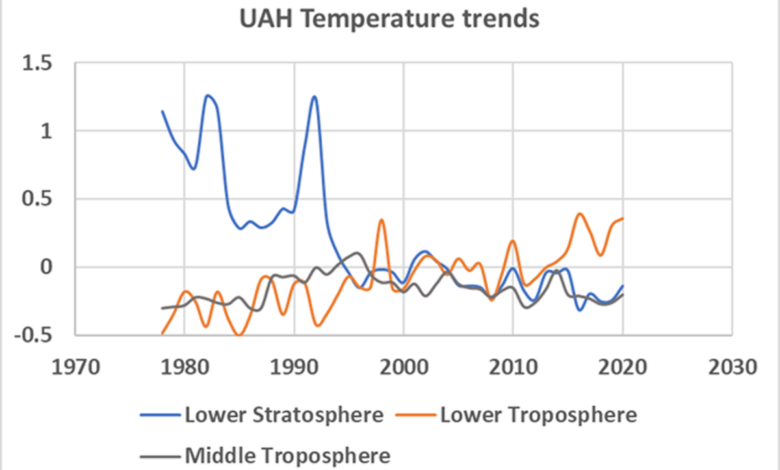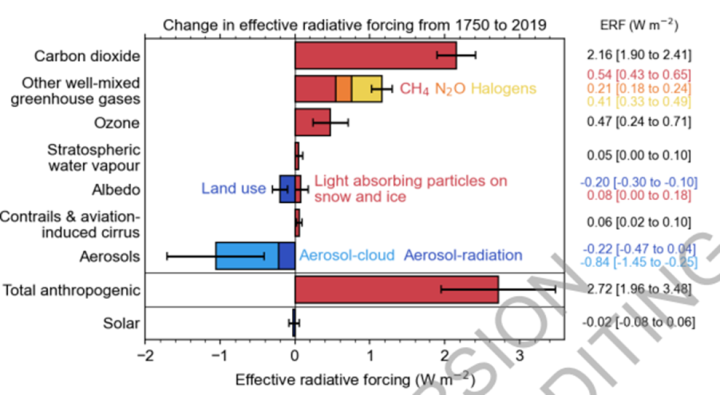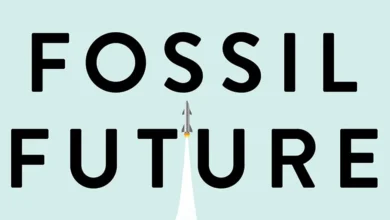Atmospheric Fingerprint – Watts Up With That?

By Andy May
The IPCC believes that the change in solar radiation over the past 60 years nets to zero and has no trend beyond the normal ~11-year solar cycle. Professor David Karoly writes that we can confidently exclude the Sun as a contributor to recent warming because, if it were, the stratosphere would be warming as a result, and instead it is cooling. The cooling of the stratosphere, when the troposphere warms, is sometimes called the “atmospheric fingerprint” of human-caused global warming. Karoly was a pioneer in this area of research (Karoly, 1989) and (Karoly, 1987).

Figure 1 shows the AR6 interpretation of the components of global warming since 1750. What is significant about this interpretation is that the Sun, which is a variable star, is assumed to be constant from 1750 to 2019 and that cloud cover is also assumed to be constant, except as a positive feedback to surface warming. Both assumptions are contested, but not thoroughly examined in AR6. The constant Sun assumption is disputed by Ronan Connolly, et al.[1] and the constant cloud cover is disputed by Henrik Svensmark and colleagues.[2]
Cooling of the stratosphere, due to a higher concentration of CO2, is logical. CO2 is a major radiator of thermal radiation in the stratosphere, and more of it should cool that layer. Likewise, if the intensity of solar radiation increased, oxygen and ozone in the stratosphere would absorb more UV (ultraviolet) radiation, which should warm the stratosphere, not cool it.
However, the idea that this pattern “points towards a discernible human influence on global climate” (IPCC, 1996, p. 439) is very controversial. There are alternate explanations for the observed stratospheric cooling, Karoly suggests that “decreases in ozone amount in the stratosphere” (Karoly, 1987) may account for the cooling. There are several other possible explanations or problems with the data used, as described by John Daly (Daly J. L., 1997). A short article in Nature, in 1996, provides a fair summary of the whole “atmospheric fingerprint” controversy, that is still accurate today. Following is a quote from the paper, written by Neville Nicholls:
“The study of Santer et al., and those reported in the IPCC Second Assessment, show that an anthropogenic component of global climate change – the ‘anthropogenic fingerprint’ – may be appearing in the observed data. It must be pointed out, however, that this signal is the complicated pattern of change resulting from the combined effects of stratospheric ozone depletion and increased concentrations of greenhouse gases and sulphate aerosols. It does not mean that the effect of any one of these factors has been detected.
Many uncertainties remain in this work and are acknowledged by Santer et al. and in the IPCC Second Assessment. There are uncertainties in estimates of the magnitude and patterns of the various natural and human-induced factors likely to affect climate. Climate models are far from perfect. There are also problems with the temperature observations: much of the similarity between the model and observed changes comes from the asymmetrical pattern of warming between the hemispheres, and the detection of that asymmetry relies on the relatively few observations of tropospheric temperatures in the Southern Hemisphere. Those observations are known to be affected by changes in instrumentation, so further work is needed to eliminate the possibility that the observed asymmetry is the result of such changes.” (Nicholls, 1996)
Neville Nicholls, like David Karoly and Benjamin Santer, was one of the authors of the critical Chapter 8 of the second IPCC report, often called SAR (IPCC, 1996, p. 407). In this chapter, the “atmospheric fingerprint” was used to justify connecting global warming to human greenhouse gas (GHG) emissions. As Nicholls writes, the so-called “atmospheric fingerprint” does provide the “clearest evidence yet that humans may have affected global climate.” (italics added) (Nicholls, 1996). However, paraphrasing Nicholls, it does not mean that the effect of human GHGs has been detected. It is logical to assume that increasing GHGs will have this effect, and it is logical to assume that humans have added significant GHGs to the atmosphere, but that is as far as it goes. We have already shown that the climate models predict too much warming in the tropical middle troposphere, if they incorporate human-emitted GHGs into their models (see here). Logical speculation is not proof.
The draft of Chapter 8 that was agreed to by the chapter authors, including Nicholls, Karoly and Santer, in July 1995, did not claim the atmospheric fingerprint showed humans were contributing to global warming. It said that, to date, the warming was within the range of normal climate variability, so a human influence could not be detected. Later that same year, in November, the conclusions of Chapter 8, were changed at the insistence of politicians and without the permission of the scientists that had written the chapter. This is the backdrop behind Nicholls’ statement above and many other protests of the changes to the chapter by scientists (May, 2020c, pp. 230-238).
A government, probably the U.S. government, insisted that Chapter 8 explicitly say that humans caused climate change. The leader of the SAR effort, John Houghton, insisted that the IPCC procedures were followed, and that the governments, that is the politicians, had the final say, not the scientists (Houghton, 1996). The IPCC reports are scientific, or they are political, they cannot be both. The scientists had already agreed that they could not be sure humans controlled the climate, because they did not know how large natural variability was. The politicians insisted this be changed, and it was. This incident, more than any other in the history of the IPCC, destroyed their reputation as an independent and unbiased reporter of the state of climate science. First, the atmospheric fingerprint was not evidence of human influence, then it was. It deserves a close look.
Satellite temperature trends in the lower stratosphere, middle troposphere, and the lower troposphere are shown in Figure 2. Stratospheric air temperatures, shown in blue, are driven by different factors than tropospheric temperatures, thus the large excursions from the trends in the 1970s to early 1990s. Since the mid-1990s, the stratosphere and middle troposphere have had the same pattern. They are both cooling while the lower troposphere is warming. Part of this pattern could be human CO2 emissions; but can we be certain of this? In a word, no. There are many natural factors that contribute to the cooling of the upper atmosphere, including less ozone that helps to warm it by absorbing ultraviolet (UV) radiation.

Benjamin Santer describes a computer model study he performed in PNAS, in 2013.[3] He used the RCP8.5 emissions scenario, which has been discredited. Jianliang Wang showed that sufficient fossil fuels do not exist to carry this emissions scenario out to the year 2100.[4]
Santer, et. al acknowledge that their “All Natural” (no human forcing) models do predict cooling in the stratosphere and warming in the lower troposphere, just as their anthropogenic models do, but says the match to observations is not as good.
As shown in Figure 2, the middle troposphere warms from the middle 1970s to the middle 1990s, and then cools until 2020, along with the stratosphere. The middle troposphere follows the lower troposphere half the time and the stratosphere the rest of the time.
Santer’s models, that include an anthropogenic effect, show the middle troposphere warming rapidly from 2000 on, like the lower troposphere. His “All Natural” model shows it staying quite flat. Neither fit the observations. Thus, his claim that the atmospheric temperature profile “provide[s] clear evidence for a discernible human influence on the thermal structure of the atmosphere” appears to be invalidated. We agree it is logical to expect additional CO2 to warm the lower troposphere and cool the stratosphere, but logical speculation is not evidence. Why does his model get the middle troposphere wrong? Compare Figure 3(B) to Figure 2.

Clearly how warming and cooling are distributed in these three sections of the atmosphere is complex and poorly understood. It is not simply human influence. If the temperature profile contains an anthropogenic signal, it has not been successfully detected or measured to date. Santer claims that his results are statistically significant, but only if we accept his assumptions that the models are robust and the Sun and other natural forcings are insignificant.
David Karoly’s other argument is that an increase in warming due to the Sun, would cause warming to be more intense during the day and in the summer. Yet, we see the opposite, warming is occurring more at night and in the winter, suggesting a warming Sun is not the cause. However, warming in the winter and at night is also consistent with more cloud cover and more cloud cover is likely as the world warms.
The Sun does not only vary in its total radiation output, or “TSI” (total solar irradiance). The Sun’s particle output, or the solar wind also varies, as does the intensity of its magnetic field. Further, TSI encompasses all radiation wavelengths, and the wavelength or its inverse, frequency, matters a lot in how radiation affects the climate. Higher frequency, more energetic UV (ultraviolet) radiation from the Sun varies much more than the total (Krummheuer & Krivova, 2015). All these variations affect Earth’s climate in ways that are poorly understood and vigorously debated.
Further, while the roughly eleven-year solar cycle exists, and is one of the few things all astrophysicists agree on, the long-term variation of the Sun is in dispute. The IPCC, Judith Lean, Leif Svalgaard, and David Karoly believe there is no long-term trend, at least over the last 300 to 400 years. They assume it is very flat, or possibly declining slightly. William Happer, and many astronomers, such as Willie Soon and Nicola Scafetta think there is a long-term or “secular” trend, and that solar variation plays a large role in global warming. We have written about this debate before, for a summary, see here. For an explanation of the various ways the Sun can influence our climate, as well as a discussion of solar activity proxies, see here.
Summary
The debate about the cause of recent global warming of Earth’s surface remains unresolved. There are several reasons why current observations, including stratospheric cooling, are inconclusive. First, the total radiation imbalance, or “forcing,” required to warm Earth’s surface one degree over the past few hundred years is extremely small, just 3-4 W/m2. This is undetectable with current technology; so, our measurements are inconclusive. As was true in 1995, when SAR was being written, we still do not know the magnitude of natural variability. Unless we know what nature can do, and is doing to our climate, we cannot detect a human influence.
Attempts to model natural climate change all assume that there is no long-term natural warming or cooling, and all warming is assigned to human influences. The huge variations in climate before humans evolved belie this assumption.
The second serious problem is we do not know what the long-term trend is in the Sun. Is it increasing its radiation output? Or is it decreasing, or staying flat? Our observations of solar output are not accurate enough to tell. Further, we do not know how the Sun affects our climate. Is the total radiation output the only thing that matters? Unlikely. Undoubtably the solar magnetic field, the frequency mix of the solar output must matter, and the solar wind surely has an influence. But we lack the ability to model these effects as discussed in Connolly, et al.
One thing is for sure, assuming the Sun and solar variability don’t affect our climate, is foolish. Yet, this assumption underlies the IPCC’s conclusion that humans are causing global warming.
The bulk of this post is an excerpt from my latest book, The Great Climate Debate, Karoly v Happer.
The bibliography can be downloaded here.
-
(Connolly et al., 2021). Connolly, et al. exhaustively examine the peer-reviewed literature on how variations in the Sun affect our climate and show that anywhere from 100% to 0% of the recent warming could be due to solar variability. The IPCC assumption of zero is not “settled science.” ↑
-
(Svensmark, Force Majeure, The Sun’s role in climate change, 2019) and (Svensmark, Influence of Cosmic Rays on Earth’s Climate, 1998) ↑
-
(Santer, et al., 2013) ↑
-
(Wang, Feng, Tang, Bentley, & Höök, 2017) ↑




